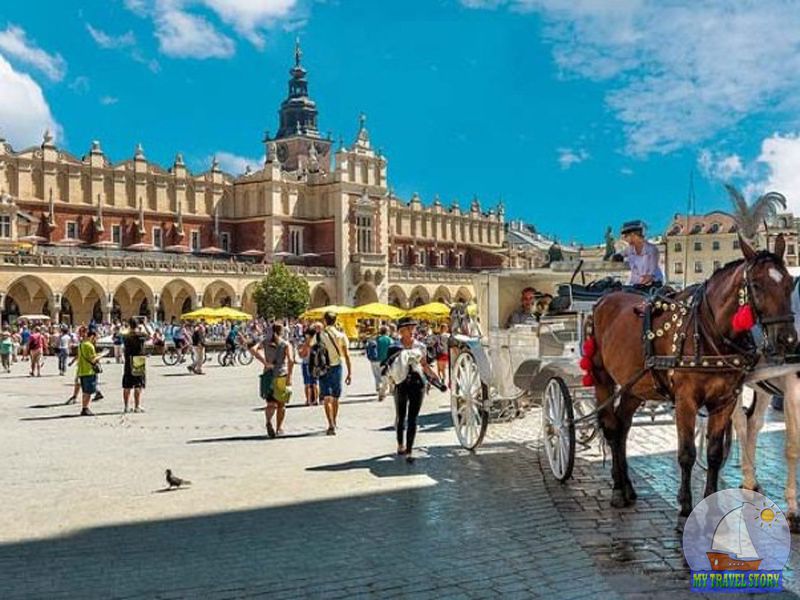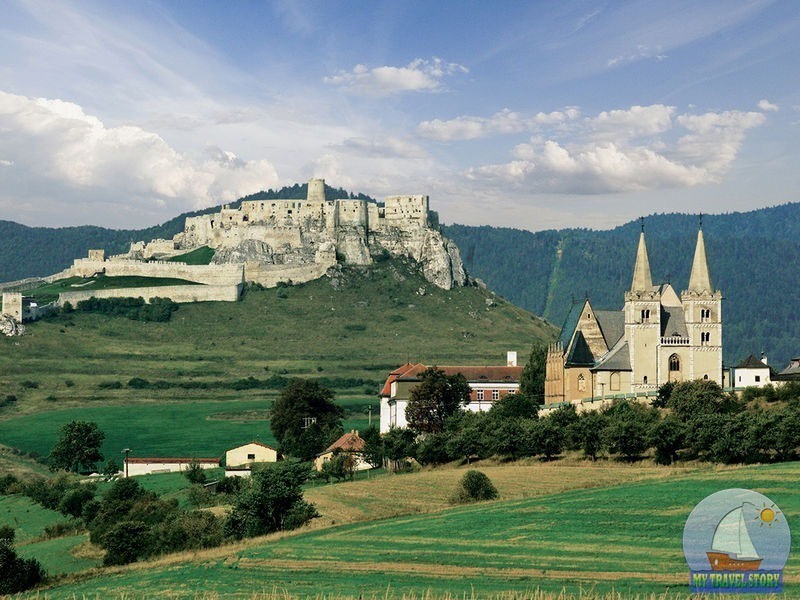
Poland – a country in Central and Eastern Europe. Capital – Warsaw; the second largest and most important city – Kraków. Total population – over 38 million people. In the north of the country bordering the Baltic Sea. The coastline stretches for about 500 km.
South-west of the country is surrounded by the Tatra Mountains, Carpathians and other mountain ranges. The highest peak – of Rysy (2499 m). Due to the climate diversity of landscapes in Poland varied. On the coast, the weather is changeable, frequent wind. There are beaches covered with dunes. In other parts of the climate is close to continental.
Official language – Polish. Also distributed Russian, English and German. According to administrative division of the country’s 16 provinces, each of which has its own capital. More than 85% of the population – Catholics.
Poland borders with many European countries. Among them: Germany, Slovakia, Ukraine, Russia and even Denmark and Sweden through the economic zone of the Baltic Sea. The main rivers – the Vistula and the Oder (Odra).
The date of foundation of the state is considered to be 966 years. In the 11th century there was the Kingdom of Poland, which in the 16th century combined with the Grand Duchy of Lithuania. The date of independence of the country is 1918. Modern border appeared after World War II.
The official currency is the Polish zloty.
Wilanów Palace

Wilanów Palace – one of the major attractions of Warsaw and All Poland; Jan III Sobieski former country house. Located on the southeastern outskirts of the city, at the end of the so-called “Royal Route”. This baroque mansion is a true “pearl” of Poland.
It was built in the second half of the 17th century King Jan Sobieski, but all the adjoining architecture with landscape and park design appeared a little later through the efforts of the next Polish rulers and their wives.

It is framed by extensive gardens and numerous buildings erected after the death of King John III. In 1805 one of the first art museums in the country was opened in the main building. During the Second World War, the museum was looted by the Nazis, but soon the exhibits were returned.
The greatest flowering house reached during the stay of Polish noble ladies E. Sinyavsky and later I. Lubomirska, popularly known as “the blue Marquis.” The palace is open to visitors daily from 9.30 am; day off – Tuesday. The nearest metro station – Wilanowska.
The interiors of the palace decorations preserved original furniture, murals, paintings, sculptures. Much of the palace tells the story of love of King Jan III Sobieski for his wife Marysieńka – former French maid of honor.
Wawel Castle
Wawel Castle – a huge complex of castle buildings in Poland, located in Kraków’s Old Town. His deservedly called the symbol and hallmark of the country. This architectural ensemble of thousands of tourists visit every year. It is a rich collection of the royal household items.

Geographically attraction is located on a small hill on the banks of the Vistula. The most important objects are considered to be the Royal Palace, which for centuries sat Polish kings, and Cathedral of Saint. Stanislaus and Wenceslaus, in which are buried the Polish monarchs, politicians, outstanding poets and national heroes.
Archaeologists have discovered that in place of the Wawel castle in the 11th century was a wooden fortification. The first stone buildings appeared during the reign of Wenceslas II, eg, at the end of the 13th century. Then it was rebuilt Wawel A. Jagiellonian Sigismund I. The last monarch who lived in the Royal Castle, was Sigismund III. The Cathedral buried Queen Jadwiga, Jan Sobieski, the poet A. Mickiewicz and many other eminent Poles.

In the castle was looted and burned during the Great Northern War. In the 18-19 centuries. he went to the Austrians, and after a brief reconstruction served as a military barracks. Conversely, he was returned to Poland only in the early 20th century. Today it is the main treasury of the state, which stores a huge collection of works of art and archives of the Krakow Metropolitan.
Since 1995, on the basis of the Cathedral organized a permanent exhibition with valuable objects once belonged to the Polish rulers. Here and royal regalia and old engravings, and the royal furniture, sculptures, gowns, garments, linen, etc. At the foot of the castle is awesome dragon – a kind of symbol of the city, which according to legend, lived in the castle cave.
The nearest stop to the attractions – Wawel. To her approaching trams 1, 3, 6, 8, and others. In fine weather, you can see at the foot of street musicians in the Polish national costume.
Auschwitz
Auschwitz – a complex of concentration camps 60 km from Krakow, Poland; the biggest death camp and forced labor, founded by the Germans during World War II. On the way he called the German Auschwitz. Today, on the site of the concentration camp located the eponymous museum, visited by millions of tourists every year.

The liberation of Auschwitz was one of the most important victories over the Nazi regime. The exact number of victims of the camp is still unknown, but according to some reports, over five years, killing more than 1.5 million people. Most of the new arrivals immediately sent to the gas chambers. At the entrance to the camp prisoners met signboard with the inscription “Work gives liberation”, which of course was not true. This sign can be seen to this day at the entrance to Auschwitz.
Trips to Auschwitz free. Anyone can visit the place where so many innocent people were killed. Thus, Auschwitz is a kind of doctrine and a sad reminder of a terrible past. Geographically, the camp was divided into three parts. Full name – Auschwitz-Birkenau, but Auschwitz was a central part of the so-called head office.

Many prisoners have died a violent death, and many – simply from exhaustion. In the barracks, which contained the prisoners, there was no heating, no normal toilets. On-site gas crematoria today arranged a memorial to the victims. When the Soviet troops liberated the camp, and it happened in January 1945, the survivors were about 7.5 thousand people. During the Auschwitz tour you can listen to the complete history of the emergence of a concentration camp in the headphones.
State Museum on the site of Auschwitz was opened in 1979. To get to it you can train from Krakow to Oswiecim to the station. Also towards Auschwitz buses and taxis from the Main Station. If you go by car, you need to adhere to the E40 highway. On inspection of the museum is better to spend about 3-4 hours.
Wieliczka Salt Mine

Wieliczka Salt Mine – one of the most unusual sights in Poland; deposit of rock salt only half an hour from Krakow. Wieliczka – a small town in Poland, which is about one million tourists annually. And all this, thanks to its unique salt mine, which tells about the history and methods of salt production for the past seven centuries.
From Krakow in the direction of Wieliczka are regular trains and taxis. We need to overcome the whole 10 km. Salt Mine is open daily from 8 am. Its examination, usually takes 1 hour 50 minutes. In fact, this underground corridors and galleries with a total length of 200 km. They are located at different depths -. 50 to 200 m Local deposits of salt about 15 million years, but they began to develop from the 13th century.. Already in the 15th century landmark Wieliczka showed Honourable gentlemen with cognitive purpose. In this visit it was possible only with the permission of the king.

The steps leading down into the mine, were equipped in the 18th century. By the beginning of the 19th century, the number of tourists reached several hundred. Center souvenir was built in modern times.
In the depths of this unique mine contains a lot of attractions. These could be considered the chapel of St. King monument Copernicus, Casimir the Great camera with his bust, mine shaft Kuchma, who served for the transport of salt, and so forth. D.
Tourists are open only a small part of the huge mine, namely, 3.5 km. At depth, in addition to historical artifacts, you can see the fantastic underground lakes, salt reliefs, numerous chambers of salt chandeliers and many other beauties. Tours are conducted in different languages, but they must be booked in advance. It is surprising that in a dungeon more than once held concerts and all kinds of celebrations.
Royal Castle in Warsaw

Royal Castle in Warsaw – one of the most visited attractions of Warsaw; the monument of the national culture in Poland. The castle was built in the late 16th-early 17th century, Sigismund III Vasa, after which the buildings on the other hand stands a monument of honor at the high tower.
Today the castle is the Art Museum, where you can see paintings of Rembrandt. Geographically, the castle is located in the Palace Square in the historic center of the city.

During the military operations in the mid-20th century, the entire architectural complex was destroyed by bombing. From 1971 to 1988, he carried out the restoration. In addition to the museum with a permanent exhibition in the castle features spacious halls, which are important symposia, conferences and even concerts.
In the afternoon free visit of the castle is a Sunday. On other days the entrance fee. The museum is open from 10 am. Some rooms have their own names, such as the Throne Room or the Knights’ Hall. The Royal Palace is visited annually by more than 500 thousand people. Find it will not be difficult, since it is located in the heart of the Old Town on the Palace Square.
Lazienki Park

Lazienki Park – the most beautiful park of Warsaw; a nature reserve and one of the most visited attractions in Poland. It’s awesome, well-groomed park in the heart of the capital. It lies on the “Royal Route” linking the Royal Castle in the center with Wilanów palace in the south-eastern outskirts.
It existed in the times of Mazovian princes. Originally, the park was conceived as a nature reserve, but there are found, in general, only the squirrels and peacocks. By the way, according to the rules we can not frighten the animals walk on the lawn or make noise. Lazienki – it’s very quiet and peaceful park. Polish monarchs loved to rest here with your family or friends. The first wooden bathing appeared thanks to Anna Yagelonke – wife of King Stefan Batory.

Sigismund III Vasa during his reign erected here Ujazdowski Palace with stunning views on the bend of the Vistula. In addition, two small pavilions were built in the park. One of them was called the Hermitage, and the other – Lazne. In honor of him, and the name “Lazenki”. Later there was an amphitheater on the one thousand people from the scene on the island. In this amphitheater, and today are performances and concerts. From sculptures occupies a special place the monument Chopin.
In the 18th century, the park was acquired by King Stanisław August, who rebuilt the baths and built a palace on the water, which is now the focal point of the park. Today, tourists can ride on the park canals, admire the royal baths and visit the museum exhibitions. The nearest metro to the sights – Politechnika. Also to the park can be reached by tram.













